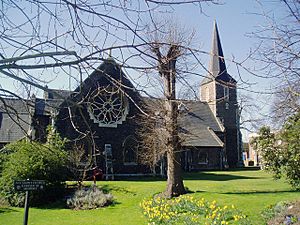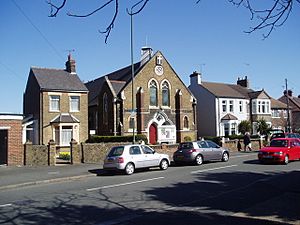Belvedere, London facts for kids
Quick facts for kids Belvedere |
|
|---|---|
 All Saints Church |
|
 Belvedere and Erith Congregational Church |
|
| Population | 11,890 (ward, 2011) |
| OS grid reference | TQ495785 |
| London borough | |
| Ceremonial county | Greater London |
| Region | |
| Country | England |
| Sovereign state | United Kingdom |
| Post town | BELVEDERE |
| Postcode district | DA17 |
| Post town | LONDON |
| Postcode district | SE2 |
| Dialling code | 020 01322 |
| Police | Metropolitan |
| Fire | London |
| Ambulance | London |
| EU Parliament | London |
| UK Parliament |
|
| London Assembly |
|

Belvedere is a town in south east London, England. It is located within the London Borough of Bexley. The town is close to the River Thames, with Erith to its east, Bexleyheath to its south, and Abbey Wood and Thamesmead to its west. Before 1965, when Greater London was created, Belvedere was part of Kent.
Contents
History of Belvedere
For many centuries, the area we now call Belvedere was part of Lessness Heath. This was a high, narrow ridge stretching from Lesnes Abbey to Erith. The northern part of this area was mostly industrial and open common land (land used by everyone).
In 1847, a large, mostly wild and wooded estate was given to Sir Culling Eardley. He started building houses in Belvedere until he passed away in 1863. Eardley built a tall wooden tower on the heath to enjoy views of his estate and the River Thames. This tower gave the area its name, "Belvedere," which means "beautiful view" in Italian. Even today, from the higher parts of Belvedere, you can see amazing views towards Canary Wharf and Central London.
Sir Culling Eardley agreed to let a chapel be built on his land. This chapel was for English Dissenters (Protestants who separated from the Church of England). The original wooden tower became part of this chapel. To help people attend, Eardley built paths across Lessness Heath. In 1861, after almost eight years of building, Eardley finished his chapel, which is now All Saints' Church. The earlier chapel with the wooden tower had burned down on the same spot. At the same time, Eardley built new houses and improved the heath path, turning it into Erith Road. As Eardley sold off more land, Belvedere village quickly grew along the path that became Bexley Road. This road was later renamed Nuxley Road in 1939.
The Great Explosion of 1864
On October 1, 1864, around 6:40 AM, a huge explosion rocked Belvedere. It completely destroyed two gunpowder factories located in a quiet area on the Belvedere side of Erith Marshes. Their storage buildings and two barges being loaded with gunpowder were also destroyed.
The explosion was so powerful that it could be heard over 50 miles away. The shockwave was so strong that people in central London thought there had been an earthquake. One report said that rescuers found a massive crater with no signs of any buildings left. It looked "as if the place had been swept clean by a broom." Luckily, only about twenty people were hurt. Even though the explosion was huge, its remote location prevented more people from being injured or losing their lives.
Belvedere in the 1900s
Before 1965, Belvedere was part of Kent and the Municipal Borough of Erith. The town grew a lot before the Second World War. Many parts were rebuilt after the the Blitz (heavy bombing during the war). Despite this, Upper Belvedere and "The Village" areas still have a lot of their original Victorian and Edwardian charm.
Between 1898 and 1961, Callender's Cable Works in Belvedere supported the Callender's Cableworks Band. This was an amateur brass band made up of company employees. The band was very popular and often played on BBC Radio in the 1920s and 1930s.
The Flood of 1953
The North Sea flood of 1953 badly affected the Belvedere Marshes area. About 1,700 people living there lost everything. One person died in the flood, and hundreds had their homes damaged. Queen Elizabeth II visited the communities of Erith and Belvedere to show her support. Many homes were without electricity for weeks after the flood.
What's in a Name?
In recent years, there has been some discussion among local residents about the correct name for the "village" part of Belvedere. This area includes Nuxley Road, Albert Road, and Woolwich Road. Council road signs call it Belvedere Village, and maps and the post office list it as Belvedere. However, some locals call it Nuxley Village, after Nuxley Road. Many residents simply call the area "The Village." It is believed that the name "Nuxley Village" might have been used by estate agents to make the area sound more appealing.
Parts of Belvedere
Belvedere has different areas within its ward:
- Erith Marshes/Crossness Nature Reserve
- Abbey Wood, Bostall Heath and Woods, Lesnes Abbey, Thamesmead, and West Heath.
Landmarks and Places to See
Upper Belvedere
Upper Belvedere has a beautiful church and lovely Victorian and Edwardian brick houses. You can find several pubs, restaurants, and shops here. Some popular spots include The Eardley Arms and the Prince of Wales on Woolwich Road, The Victoria on Victoria Street, and The Royal Standard, The Village Inn, and The Fox all on Nuxley Road.
Upper Belvedere also has a large park and a local library. The library was almost closed due to funding cuts, but the local community worked hard to keep it open. A "Splash Park" opened in 2005, which was a fun addition. It was built on the site of an old Victorian paddling pool and kept some of its original features. The Splash Park closed in 2016 and was replaced by a new play area called Belvedere Beach, which opened in 2017.
Lower Belvedere
Lower Belvedere is smaller than Upper Belvedere. It is more industrial and closer to Belvedere railway station. It has a Methodist chapel and a Sikh Temple. To its north, it borders Crossness, an area near the Thames. Crossness has a small industrial park, the Belvedere Incinerator (a large plant that turns waste into energy), and the Crossness Sewage Treatment Works. This treatment works has a high-tech system that burns sludge methane and features Joseph Bazalgette's Victorian Crossness Pumping Station. Lower Belvedere is also home to the Belvedere Community Forum, which meets at the Belvedere Community Centre.
Historic Buildings
The Grade II Listed Bexley College was designed in 1906. It is located on Erith Road, at the eastern edge of the district, near Erith.
The Woolwich Road Conservation Area was created in 1992 by Bexley Council. This area is special because of its Victorian character and many historic buildings. It includes the Eardley Arms and Prince of Wales pubs, the DVLA Driving Test Centre (which was the original Belvedere Police Station built in the 1880s), Belvedere Recreation Grounds, and large houses along Woolwich Road and Gloucester Road. These houses were built for wealthier Victorian families, perhaps for professionals or business owners in Erith and Woolwich.
The former Woolwich Road police station was built in 1881. It was designed to match the nearby houses. At that time, Belvedere had two inspectors, three sergeants, and twenty-six police officers. It remained an active police station until 1968. A new, much larger station was built on the corner of Nuxley Road and Woolwich Road. This new station closed in 2015 and was sold for redevelopment in 2018.
Places of Worship
- All Saints Belvedere, Nuxley Road
- Free Grace Baptist Church, Nuxley Road, Belvedere
- Belvedere Congregational Church, Picardy Road
- Belvedere Baptist Church
- Belvedere Methodist Church
- St Augustine, Belvedere
- Ichthus Community Church, Belvedere
- Belvedere Pentecostal, Mitchell Close
- Guru Nanak Darbar, Sikh Temple, Mitchell Close
People of Belvedere
According to the 2011 census, 65% of the people living in Belvedere were White British, and 12% were Black African.
Education in Belvedere
For information about schools in Belvedere, you can visit the main article on London Borough of Bexley#Education.
Sports in Belvedere
Erith and Belvedere Football Club recently moved to Welling and shares a ground there. Belvedere Football Club and Belvedere Cricket Club play at Memorial Sports Ground on Woolwich Road in Abbey Wood. They compete in the Kent County League Division One (West).
Bexleyheath and Belvedere Hockey Club is based in Welling. However, they play some of their home matches at Erith School.
Getting Around Belvedere
Trains
Belvedere railway station opened in 1859. It is in Lower Belvedere and is served by the North Kent Line. This line runs from London Cannon Street to Dartford, Gravesend, and Gillingham (Kent). Belvedere also benefits from the Docklands Light Railway connection at nearby Woolwich. The Elizabeth line, a new train service, opened in 2022 at the neighboring Abbey Wood.
Buses
Several Transport for London bus services serve Belvedere. These buses connect the town with areas like Thamesmead, Erith, Bexleyheath, Woolwich, and Sidcup.
Green Chain Walk
The Green Chain Walk is a long path that mostly runs east to west along the northern slopes of the ridge. It stretches from Plumstead Common to Erith. This walk offers a shortcut to the Thames Path, and you can connect to it in three different places.
Driving
Driving test results from 2013-14 showed that the Belvedere test centre had the lowest pass rate in Great Britain. More recently, between 2022 and 2023, the Belvedere test centre had the second lowest pass rate in the country. The nearby Erith test centre had the lowest pass rate during that time.
There is a proposed Belvedere Crossing project. This would be a new bridge or tunnel across the River Thames between Belvedere and Rainham.
Geography of Belvedere
Belvedere is bordered by the River Thames to the north. To the north east and east is Erith. Northumberland Heath is to the south east and south. West Heath is to the south west, Abbey Wood to the west, and Thamesmead to the north west.
Famous People from Belvedere
- Billy Cornelius (1898–?), professional football player and manager, born in Belvedere
- Alec Debnam (1921–2003), cricketer, born in Belvedere
- Walter Donaldson (1907–1973), Scottish snooker player, lived for some years in Grosvenor Road
- Roy Dwight (1933–2002), footballer (Nottingham Forest), born in Belvedere
- Mike Kelly (born 1954), footballer (Millwall FC), born in Belvedere
- Alan Knott (born 1946), cricketer, born in Belvedere, attended Northumberland Heath Secondary Modern School
- Charlie Revell (1919–1999), footballer
- Colin Seeley (1936–2020), champion motorcyclist and motorbike designer, lived in Belvedere and worked on Nuxley Road
- Flaxman Charles John Spurrell (1842–1915), archaeologist, geologist and photographer, lived at The Priory, Picardy Road
- Anne Swithinbank (born 1957), horticulturist and gardening writer, born in Belvedere


